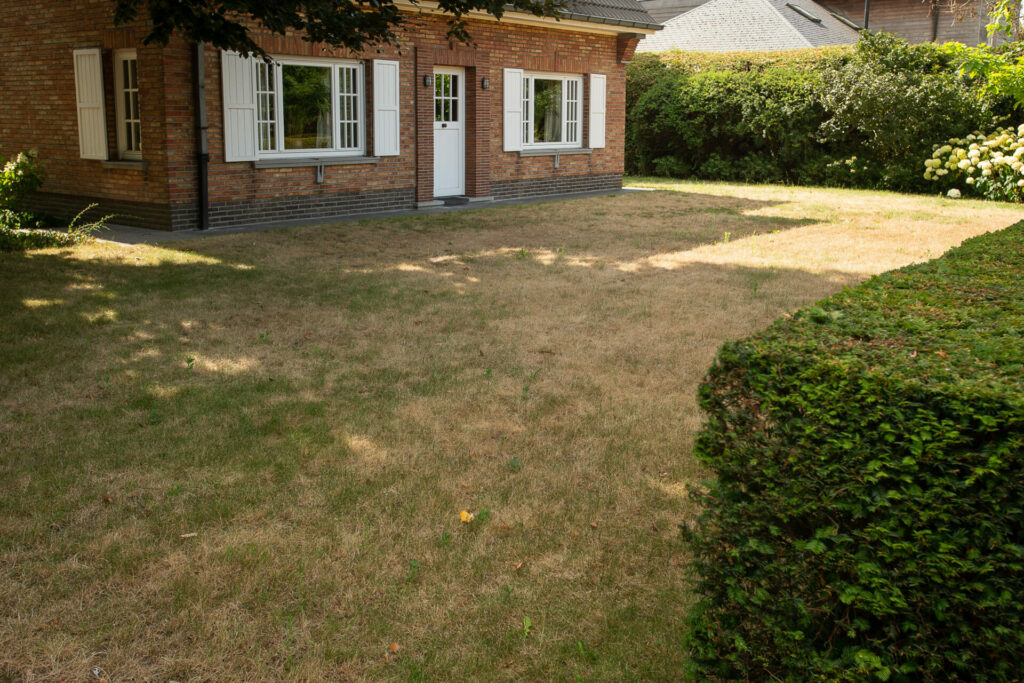A walk through any residential area in Flanders is evidence of this summer's drought, with the grass in most gardens turning brown and sooner than in any previous year. The grass now isn't greener on any side as the vicious cycle of climate warming becomes visible.
The effects of the heat that has engulfed Belgium in recent weeks and the lack of rainfall are highlighted in the latest data from the citizen survey CurieuzeNeuzen that assessed the state of some 3,000 Flemish gardens.
"The drought sees Flemish lawns at their driest in two years, which is not surprising given that last year was the wettest summer since records began," Jonas Lembrechts, an ecologist at the UAntwerpen who is coordinating the research project, told The Brussels Times.
This brings Belgium back in line with the very dry summers it experienced in the three years before (2021). This summer, just 5% of respondents indicated that their lawns are still fresh green. "More than half were completely brown last week," Lembrechts said.
Is brown grass cause for alarm?
Grass turning brown is nothing new. As temperatures rise and rainfall becomes less frequent, it is natural for lawns to lose their green colour, especially if they are on warmer and drier grounds.
"This is not necessarily a problem. Lawns turn brown (and trees go into autumn mode, which we are seeing more and more) as a defence mechanism; they will try to come alive again when there is water," Lembrechts explained.

Severe droughts are resulting in trees going into autumn mode sooner. Credit: Belga
The problems start when they keep "getting hit by the same hammer, year after year," putting the most vulnerable plant species in danger. "I have heard stories of trees dying because of this drought," he said, explaining that this earlier autumn mode means plants and trees have shorter growing seasons and have less time to build up reserves.
When it comes to people's lawns, especially when cut short, the grass will struggle to recover. "They also have shorter roots, meaning they cannot reach the deeper water reserves. Lawns with little diversity (without weeds) are also more vulnerable."
Long-term effects
While this effect is not necessarily problematic in the short term, it can have a more dramatic impact in the longer term. "Part of the problem we are seeing now, which will continue in the coming weeks, is that the browning of lawns means they lose their natural air-conditioning function," Lembrechts said.
In normal conditions, green vegetation can keep itself cool by evaporating water. Yet this natural air-conditioning function stops working as plants contain less water.
Consequently, the ground warms up even more, creating a feedback loop and amplifying the impact of the drought later in the season.
Lowering nature's resilience
The warming climate has also seen more and more plant species from Southern Europe take root further north since they have better defence mechanisms against warmer climates.
"As long as these are species from Europe, this is a natural process and not necessarily dramatic. But these rapid changes are weakening the resilience of nature, because the species are no longer in tune with each other," Lembrechts explained.
Related News
- Rising levels and warmer water: Effects of climate change on seas increasingly evident
- Almost half of Europe at risk of drought
This change will only happen more quickly as the air-conditioning function of vegetation is diminished, inevitably resulting in more drought and more heat.
In Flanders, the Blue Deal – which aims to combat drought and water scarcity through investments in infrastructure – is already helping to retain water as levels fall. Yet Lembrechts says that much more needs to be done.
"Change can also be made at the garden level, think of rainwater wells and rain barrels. As long as we keep the 'soil sponge' wet, the natural air-conditioning function can work. We should do that for as long as possible."


